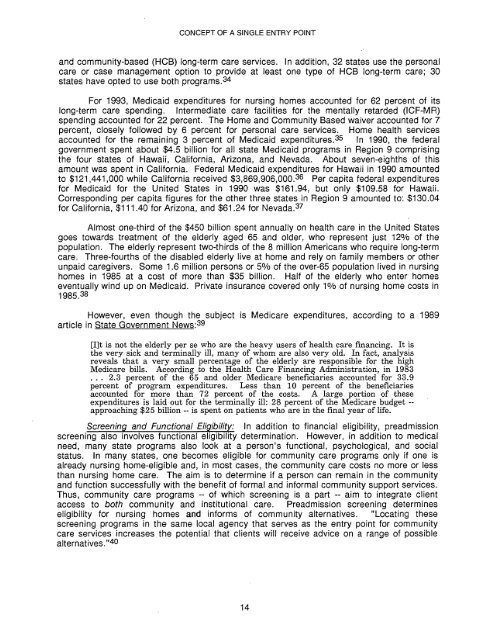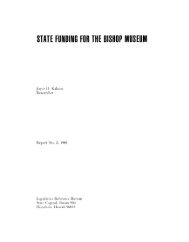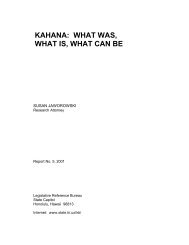long-term care - Legislative Reference Bureau
long-term care - Legislative Reference Bureau
long-term care - Legislative Reference Bureau
You also want an ePaper? Increase the reach of your titles
YUMPU automatically turns print PDFs into web optimized ePapers that Google loves.
CONCEPT OF A SINGLE ENTRY POINT<br />
and community-based (HCB) <strong>long</strong>-<strong>term</strong> <strong>care</strong> services. In addition, 32 states use the personal<br />
<strong>care</strong> or case management option to provide at least one type of HCB <strong>long</strong>-<strong>term</strong> <strong>care</strong>; 30<br />
states have opted to use both programs. 34<br />
For 1993, Medicaid expenditures for nursing homes accounted for 62 percent of its<br />
<strong>long</strong>-<strong>term</strong> <strong>care</strong> spending. In<strong>term</strong>ediate <strong>care</strong> facilities for the mentally retarded (ICF-MR)<br />
spending accounted for 22 percent. The Home and Community Based waiver accounted for 7<br />
percent, closely followed by 6 percent for personal <strong>care</strong> services. Home health services<br />
accounted for the remaining 3 percent of Medicaid expenditures. 35 In 1990, the federal<br />
government spent about $4.5 billion for all state Medicaid programs in Region 9 comprising<br />
the four states of Hawaii, California, Arizona, and Nevada. About seven-eighths of this<br />
amount was spent in California. Federal Medicaid expenditures for Hawaii in 1990 amounted<br />
to $121,441,000 while California received $3,869,906,000. 36 Per capita federal expenditures<br />
for Medicaid for the United States in 1990 was $161.94, but only $109.58 for Hawaii.<br />
Corresponding per capita figures for the other three states in Region 9 amounted to: $130.04<br />
for California, $111.40 for Arizona, and $61.24 for Nevada. 37<br />
Almost one-third of the $450 billion spent annually on health <strong>care</strong> in the United States<br />
goes towards treatment of the elderly aged 65 and older, who represent just 12% of the<br />
population. The elderly represent two-thirds of the 8 million Americans who require <strong>long</strong>-<strong>term</strong><br />
<strong>care</strong>. Three-fourths of the disabled elderly live at home and rely on family members or other<br />
unpaid <strong>care</strong>givers. Some 1.6 million persons or 5% of the over-65 population lived in nursing<br />
homes in 1985 at a cost of more than $35 billion. Half of the elderly who enter homes<br />
eventually wind up on Medicaid. Private insurance covered only 1% of nursing home costs in<br />
1985. 38<br />
However, even though the subject is Medi<strong>care</strong> expenditures, according to a 1989<br />
article in State Government News: 39<br />
[I]t is not the elderly per se who are the heavy users of health <strong>care</strong> fmancing. It is<br />
the very sick and <strong>term</strong>inally ill, many of whom are also very old. In fact, analysis<br />
reveals that a very small percentage of the elderly are responsible for the high<br />
Medi<strong>care</strong> bills. According to the Health Care Financing Administration, in 1983<br />
.. , 2.3 percent of the 65 and older Medi<strong>care</strong> beneficiaries accounted for 33.9<br />
percent of program expenditures. Less than 10 percent of the beneficiaries<br />
accounted for more than 72 percent of the costs. A large portion of these<br />
expenditures is laid out for the <strong>term</strong>inally ill: 28 percent of the Medi<strong>care</strong> budget -approaching<br />
$25 billion -- is spent on patients who are in the final year of life.<br />
Screening and Functional Eligibility: In addition to financial eligibility, preadmission<br />
screening also involves functional eligibility de<strong>term</strong>ination. However, in addition to medical<br />
need, many state programs also look at a person's functional, psychological, and social<br />
status. In many states, one becomes eligible for community <strong>care</strong> programs only if one is<br />
already nursing home-eligible and, in most cases, the community <strong>care</strong> costs no more or less<br />
than nursing home <strong>care</strong>. The aim is to de<strong>term</strong>ine if a person can remain in the community<br />
and function successfully with the benefit of formal and informal community support services.<br />
Thus, community <strong>care</strong> programs -- of which screening is a part -- aim to integrate client<br />
access to both community and institutional <strong>care</strong>. Preadmission screening de<strong>term</strong>ines<br />
eligibility for nursing homes and informs of community alternatives. "Locating these<br />
screening programs in the same local agency that serves as the entry point for community<br />
<strong>care</strong> services increases the potential that clients will receive advice on a range of possible<br />
alternatives. "40<br />
14
















